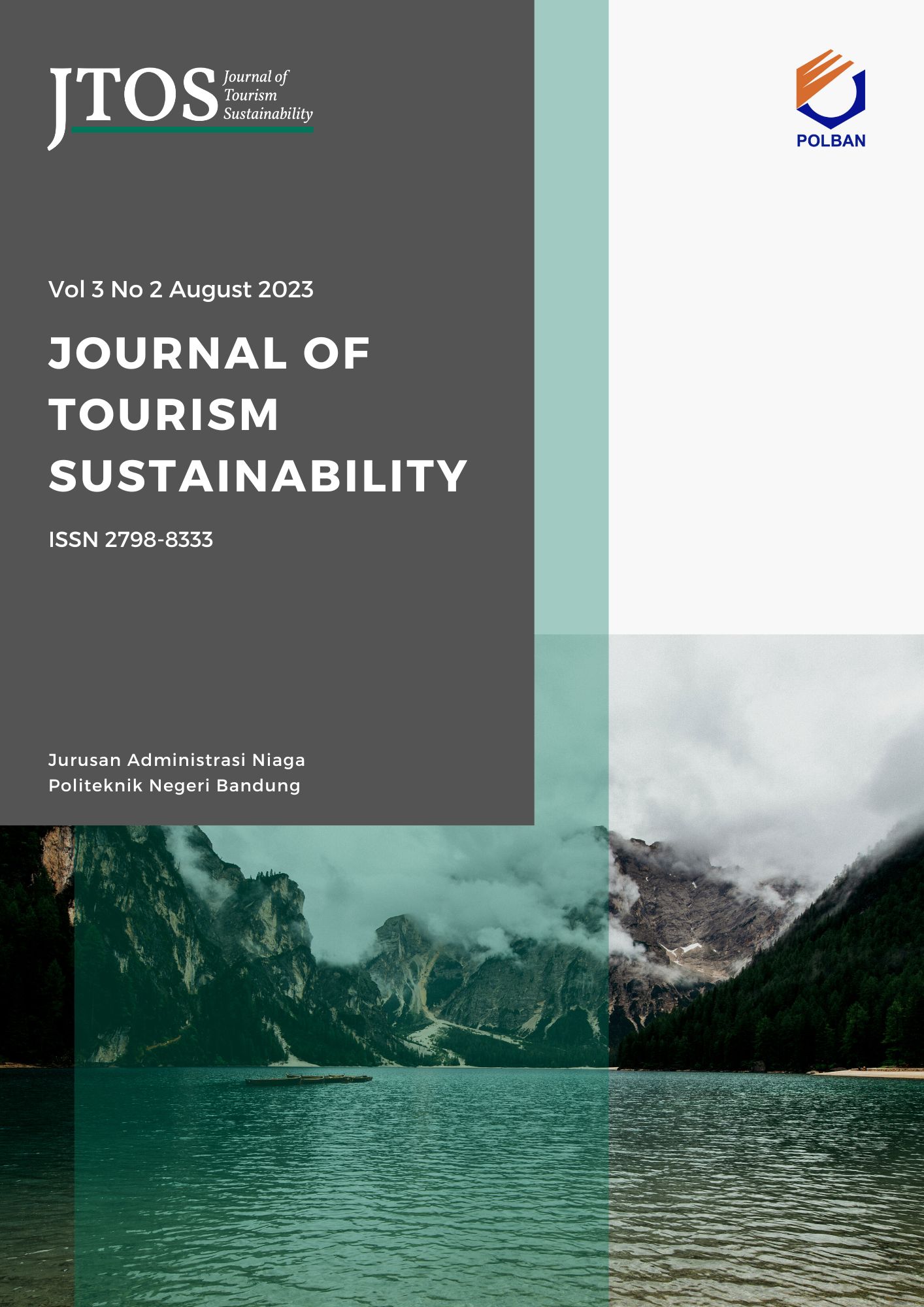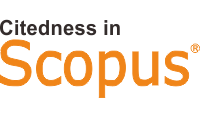Mangroves Addition as Innovation for Sustainable Tourism
DOI:
https://doi.org/10.35313/jtospolban.v3i2.84Keywords:
Mangroves addition, Grand Maerokoco, Economic valution, Noise measurement, Sustainable TourismAbstract
Grand Maerokoco is a tourist site in Semarang, located close to Marina beach. The presence of mangroves in Maerokoco, is expected to protect it from the coastal disaster, as well as to make it as a new attraction. This study assessed the benefits of mangroves addition in Grand Maerokoco according to visitor perception, economic valuation toward mangrove plantation in there, and its ability to reduce noises. Visitor perception could be known by conducting interviews. Economic valuation measurement employed was TCM (Travel Cost Method). Then for determining the ability to reduce noises, a noise measurement using sound level meter was conducted. Based on visitor perception, existence of mangroves in Grand Maerokoco can increase the attraction, increase the number of visitors, make the air cooler and cleaner, reduce the noise, and prevent the entry of coastal floods. The existing noise known at some point of crowds is still below the threshold standards of the EPA (Environmental Protection Agency), caused by mangroves in Maerokoco are high and dense. The potential consumer surplus value per individual per visit is Rp717,792.00. The value indicates the visitors get the benefits of environmental services greater than the cost incurred. For increasing the values, utilizing mangroves for education and agribusiness functions, along with maintenance should be done.
References
Akhyar, M., Ernawati, R., & Suriani, E. (2020). Perancangan fasilitas wisata edukasi mangrove di Pantai
Timur Surabaya dengan pendekatan ekologi arsitektur. Mozaik, 10(10), 1-8.
Batubara, I.K., Yulinda, E., & Warningsih, T. (2020). Economic valuation of tourism Pasumpahan Island West
Sumatera with travel cost method. IOP Conf. Ser.: Earth Environ. Sci., 430(012024), 1-7. doi:10.1088/1755-1315/430/1/012024.
Beeler, C. (2016). One man is planting mangroves in Indonesia to stave off tragedy (online). Boston: The World. https://theworld.org/stories/2016-12-23/one-man-planting-mangroves-indonesia-stave-tragedy
Bohol Tourism Office Organizational. (2006). Marine habitats and coastal resources. Biodiversity Conservation and Ecotourism Framework Plan of Bohol, 2(5), 9-17.
China Coastal Wetland Conservation Network. (2020). Report on China Mangrove Conservation and Restoration Strategy Research Project: Executive Summary.
Diarto, D., Hendrarto, B., & Suryoko, S. (2012). Partisipasi masyarakat dalam pengelolaan lingkungan kawasan Hutan Mangrove Tugurejo di kota Semarang. Jurnal Ilmu Lingkungan, 10(1), 1-7. doi:10.14710/jil.10.1.1-7
Dobson, M., & Ryan, J. (2000). Trees and shrubs for noise control. Arboricultural Advisory and Information Service, 1-7.
Durbarry, R. (2017). Research Methods for Tourism Students (1st ed.). London: Taylor & Francis Ltd, 145-157. doi:10.4324/9780203703588
Fatimah, N. (2008). Pengelolaan dan pengembangan pariwisata budaya di kota Semarang (studi kasus terhadap obyek wisata Maerokoco). Forum Ilmu Sosial, 35(1), 82-90. doi:10.15294/fis.v35i1.1304
Gailis, J.A. (2014). A Consumer Surplus Estimate of Peace and Love Festival in Borlange: A Travel Cost Approach (2-3 ed.). Sweden: Hogskolan Dalarna Project, 3-19.
Habiby, W. N. (2017) Statistika Pendidikan. Surakarta: Muhammadiyah University Press.
Hana, S., & Aris, W. (2017). Jelajahi "tracking mangrove" di Puri Maerokoco (online). Jawa Tengah: Antara News. https://jateng.antaranews.com/berita/159607/jelajahi-tracking-mangrove-di-puri- maerokoco
Jati, I.W., & Pribadi, R. (2018). Economic Valuation as an Instrument to Determine The Management Strategy of Baros Mangrove Forest, Bantul, Yogyakarta, Indonesia. Icenis, 31(08024), 1-4. doi: 10.1051/e3sconf/20183108024
Kill, J. (2015). Economic Valuation and Payment for Environmental Service. Berlin: Heinrich Böll Foundation, 4-7.
Abdurokhim, & Guterres, A. (2023). Aligning Rural Tourism With Local Realities: Strategic Formulation Through AHP And TOWS In West Java. Journal of Tourism, Hospitality and Travel Management, 1(2), 92–106. https://doi.org/10.58229/jthtm.v1i2.311
Hidayah, N., Salsabila, R. K., Saputra, R. A., Dewi, E. K., Jannatan, M. W., Nufus, N. H., Fahriza, A., & Monicawati, S. (2023). Instagram Social Media Marketing Communication Performance Evaluation @Baturadenpalawi. Journal of Tourism, Hospitality and Travel Management, 1(1), 8–16. https://doi.org/10.58229/jthtm.v1i1.7
Irfansyah, Hidayat, N. M., Purnama, R., Resmi, I. C., & Nurizki, R. (2023). Identification of Culinary Potential in Neglasari Village, Cisompet, Garut. Journal of Tourism, Hospitality and Travel Management, 1(1), 29–34. https://doi.org/10.58229/jthtm.v1i1.11
Octaviany, V., Hasyim, M. A. N., Gusnadi, D., & Mardiyana, E. (2023). From Utility to Intention: Unpacking the Drivers of Smart Hotel Adoption in the Digital Native Segment. Journal of Tourism, Hospitality and Travel Management, 1(2), 76–91. https://doi.org/10.58229/jthtm.v1i2.309
Prawira, M. F. A., Budisetyorini, B., Salam, D. A., Adisudharma, D., & Wulandari, W. (2023). Ciletuh Geopark Destination Development: Integrating Alternative Food in Hanjeli Tourism Village and Surrounding Destinations. Journal of Tourism, Hospitality and Travel Management, 1(2), 35–45. https://doi.org/10.58229/jthtm.v1i2.139
Salam, D. A., Wyratama, M. Y., Natasha, I., Pramesthi, R. I., Ahzar, A. A., Syafitri, M. A., & Novianti, S. (2023). Community Participation in Agrotourism Development in Cibodas Village, Lembang District, West Bandung Regency. Journal of Tourism, Hospitality and Travel Management, 1(1), 23–28. https://doi.org/10.58229/jthtm.v1i1.10
Suryana, M. (2023). Navigating Digital Trust: How Service Quality and Brand Image Shape Loyalty in Online Travel Platforms. Journal of Tourism, Hospitality and Travel Management, 1(2), 62–75. https://doi.org/10.58229/jthtm.v1i2.306
Susanto, E. (2023). From Taste to Travel : Exploring the Behavioral Drivers of Local Food Engagement and Revisit Intention in Food Tourism Food Authenticity Perception and Tourist Intention. Journal of Tourism, Hospitality and Travel Management, 1(2), 46–61. https://doi.org/10.58229/jthtm.v1i2.304
Widiarrachman, R. F., Rahtomo, W., Putri, A. S. S., Annisa, G. N., Wicaksono, M. A., Nareswari, N., Sakti, N. P., Lathifa, P. H., & Ningtyas, W. A. (2023). Market Profile Analysis of Lokawisata Baturraden. Journal of Tourism, Hospitality and Travel Management, 1(1), 1–7. https://doi.org/10.58229/jthtm.v1i1.6
Wulandari, W., Sianturi, A., Rahmadiani, A., Nurinto, B., Raudhatul, K. J., Marsha, A., Rizqy, M., & Yulia, S. M. (2023). Electronic Word Of Mouth On Visiting Decisions. Journal of Tourism, Hospitality and Travel Management, 1(1), 17–22. https://doi.org/10.58229/jthtm.v1i1.8
Loughland, R., Butt, S.J., & Nithyanandan. (2020). Establishment of mangrove ecosystems on man-made islands in Kuwait: Sustainable outcomes in a challenging and changing environment. Aquatic Botany, 167, 103273. doi: 10.1016/j.aquabot.2020.103273
Lovelock, C.E., Barbier, E., & Duarte, C.M. (2022). Tackling the mangrove restoration challenge. Plos Biol, 20(10), 1-15, doi: 10.1371/journal.pbio.3001836.
Miranda, C., Soemardiono, B., & Noerwasito, V.T. (2017) Eco-Architecture: the design of floating culinary tourism center. IJERT, 6(2), 159 - 163. doi:10.17577/IJERTV6IS020033
Pajo, B. (2017). Introduction to Research Methods: A Hands-On Approach. Los Angeles: Sage Publications.
Payne, S.R. (2008). Are perceived soundscapes within urban parks restorative?. The Journal of the Acoustical Society of America, 123(5), 3809. doi:10.1121/1.2935525
Ramos, S.J. & Hesp, P.A. (2018). Mangrove Establishment in an Artificially Constructed Estuarine Channel, Sungei Api-Api, Singapore. In Makowski C. & Finkl C. (Eds.) Threats to Mangrove Forests. Coastal Research Library (pp. 419-427), 25. Cham: Springer. doi: 10.1007/978-3-319-73016-5_19
Song, S., Ding, Y., Li, W., Meng, Y., Zhou, J., Gou, R., Zhang, C., Ye, S., Saintilan, N., Krauss, K.W., Crooks, S., Lv, Shuguo & Lin, G. (2023). Mangrove reforestation provides greater blue carbon benefit than afforestation for mitigating global climate change. Nature Communication, 14(756), 1-11. doi: 10.1038/s41467-023-36477-1
Spacek, J., & Antouskova, M. (2013). Individual single-site travel cost model for Czech Paradise Geopark. Acta Universitatis Agriculturae Et Silviculturae Mendelianae Brunensis, 61(7), 2851-2856. doi:10.11118/actaun201361072851
Tamaei, S. (2005). Study of gray mangrove (Avicennia marina) afforestation for greening of desert coasts: Gray mangrove afforestation on banks of artificial channel across a sabkha and the established biotic community. Japanese Journal of Ecology, 55(1), 1-9.
The Nature Conservancy. (2020). Mangroves (online). Virginia: The Nature Conservancy Post. https://www.natureprotects.org/posts/mangroves
Thill, J.C., & Kim, M. (2005). Trip making, induced travel demand, and accessibility. Journal of Geographical System, 7(2), 229–248. doi:10.1007/s10109-005-0158-3
Wahyuningtyas, A., Pahlevari, J.E., Darsono, S. & Budieny, H. (2017). Pengendalian banjir sungai Bringin Semarang,” Jurnal Karya Teknik Sipil, 6(3), 161-171.
Wubalem, A., Woldeamanuel, T., & Nigussie, Z. (2023). Economic Valuation of Lake Tana: A Recreational Use Value Estimation through the Travel Cost Method. Sustainability, 15(6468), 1-20. doi: 10.3390/su15086468
Downloads
Published
Issue
Section
License
Copyright (c) 2024 Janne Hillary

This work is licensed under a Creative Commons Attribution-NonCommercial-ShareAlike 4.0 International License.



.png)

















